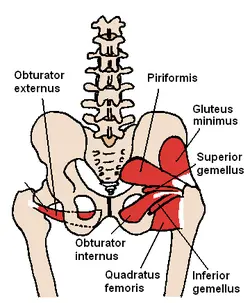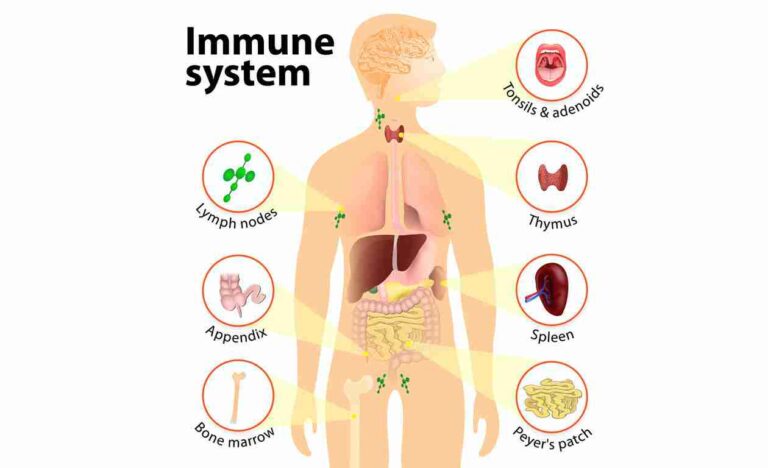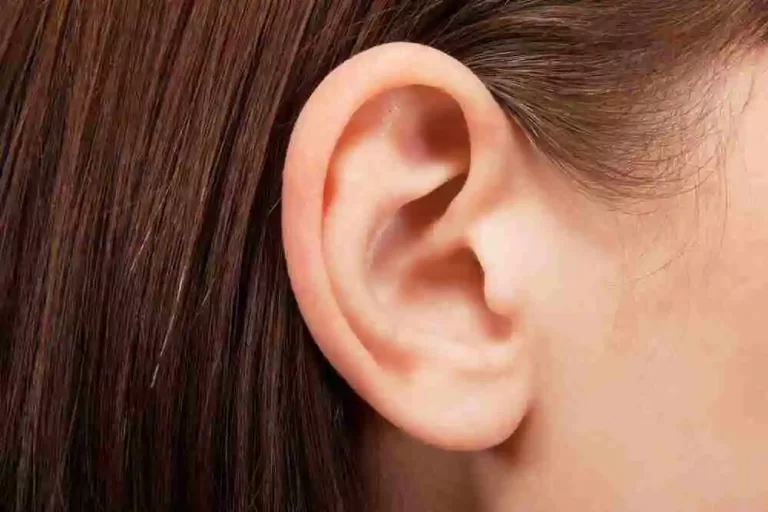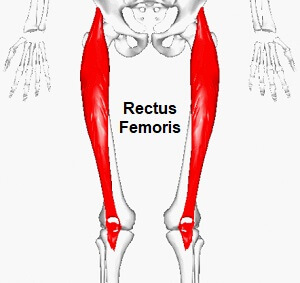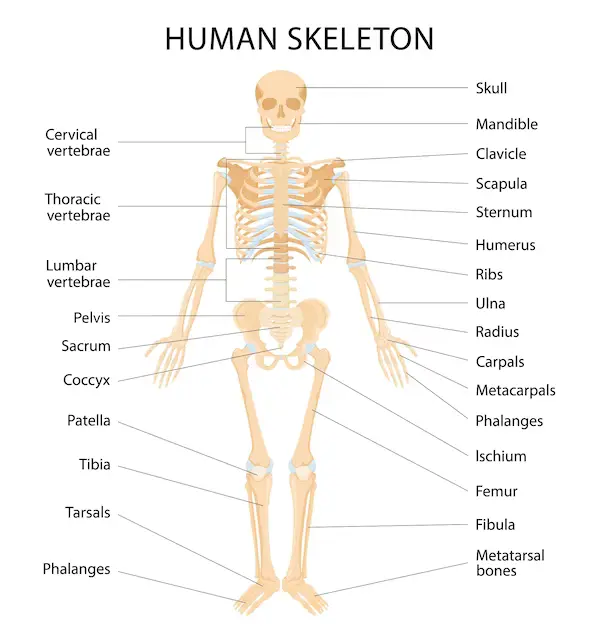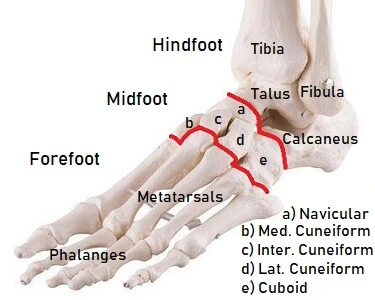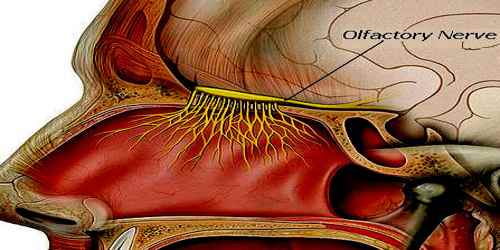Inferior gemellus muscle Origin, Insertion, Function, Exercise
Table of Contents
Introduction
- The inferior gemellus muscle is a small, paired muscle situated in the deep gluteal region of the lower extremity. It is part of a larger, tricipital (3-headed) muscle complex known as triceps coxae (triceps of the hip) which also includes the superior gemellus & obturator internus muscles. As the Gemelli muscles (superior, inferior) are the smaller of the 3 &less capable of independent actions, they are considered accessory reinforcements to the obturator internus.
- The inferior gemellus muscle extends from the ischium of the coxal bone until the greater trochanter of the femur, hence it is sometimes referred to as an inner hip muscle. Contraction of the inferior gemellus muscle aids with external rotation & abduction of the thigh (the latter only from thigh flexion). It also keeps the stability of the head of the femur inside the acetabulum of the coxal bone.
Origin & insertion of Inferior gemellus muscle
- The inferior gemellus muscle is located between the coxal bone & femur.
- It originates from the lateral surface (upper part) of the ischial tuberosity, inferior to the groove occupied by the tendon of the obturator internus muscle.
- It courses horizontally on a lateral side, integrated with the inferior border of the tendon of the obturator internus. The inferior gemellus muscle then attaches to the medial surface of the greater trochanter of the femur via this tendon.
Relations
- The inferior gemellus muscle forms part of the triceps coxae muscle complex, which is situated in the deep layer of the gluteal region between the piriformis & the quadratus femoris muscles. The inferior gemellus muscle is overlaid superficially by the gluteus maximus muscle, while the hip joint lies deep, or anterior, to it. The nerve to the quadratus femoris muscle descends deep to the inferior gemellus muscle after exiting the pelvis through the greater sciatic foramen. The sciatic nerve, posterior femoral cutaneous nerve & inferior gluteal artery source superficially, or posterior, to inferior gemellus.
- After the obturator internus muscle exits the pelvis through the lesser sciatic foramen, the inferior gemellus forms a muscular canal for its tendon. The inferior gemellus muscle travels inferior to the tendon initially, & then passes anterior to it as they approach the insertion point on the femur.
Functions of Inferior gemellus muscle
- The inferior gemellus muscle is an accessory reinforcement to the obturator internus muscle, aiding it in its function. This aspect is necessary because the obturator internus loses a proportion of its power once it leaves the pelvis & turns almost ninety degrees when crossing the lesser sciatic foramen.
- Inferior gemellus muscle work on the hip joint, causing 3 major movements. When the thigh is in an anatomical position, it pulls the greater trochanter of the femur posteriorly, surrounds the bone’s longitudinal axis, and sources external (lateral) rotation of the thigh. The hip, & the thigh, are flexed, inferior gemellus muscle drags the upper femur medially. This action is recompensated by the lower femur moving laterally, the outcome in thigh abduction. The inferior gemellus muscle also reinforces the coherence of the hip joint, stabilizing the head of the femur inside the acetabulum.
Nerve supply
- Inferior gemellus receives supplied by the nerve to quadratus femoris which is a branch of the sacral plexus. It originates from L4, L5 & S1 spinal nerves.
Blood supply
- The inferior gemellus muscle collects arterial blood from the medial circumflex femoral artery, which originates from the deep femoral artery. After vascularizing the muscle, the medial circumflex femoral artery resume further to supply the neck of the femur.
Clinical importance
- The inferior gemellus is located in the pelvic region between the obturator externus & obturator internus. Its main function is external rotation & helps to stabilize the hip joint. There are a total of 6 hip rotator muscles: piriformis, obturator externus/internus, quadratis femoris, & gamellus inferior/superior.
- The functionality of the inferior gemellus can be assessed by having a patient sit with their hips forming a 90-degree angle. The patient must then laterally rotate the hip. Any limitation in the range of motion or pain may indicate injury or dysfunction in the inferior gemellus.
- Injury to the inferior gemellus may make daily leisure activities challenging to do. For instance, any activities which need maneuvering while in a squatting position like gardening will cause pain & discomfort.
- Asymmetrical training of the inferior gemellus will result in discomfort, decreased range of motion on the weaker side, and loss of hip rotation function. Care should be taken to complete strengthening exercises & stretches equally on both sides. If one side appears weaker, you might complete additional sets on that side.
- Retrotrochanteric gluteal & thigh pain may be indicative of injury to the Gemelli-obturator internus complex. This has main implications for the diagnosis & treatment of debilitating gluteal pain.
Inferior gemellus exercises
stretching exercise of inferior gemellus
Three-point hip rotation:
- One of the best exercises to do to strengthen the hip rotators, including the inferior gemellus, is a 3-point hip rotation.
- Position yourself on your hands & knees on a flat but comfortable surface. Bring the right knee into the chest with the knee flexed (bent). Then rotate the leg out to the right & then to the back. Bring the knee back to the chest. Complete a total of 10 rotations on each leg. Make sure the movement is smooth & controlled throughout the exercise. This exercise can also do in a standing position.
FAQ
The inferior gemellus muscle arises from the upper part of the ischial tuberosity, immediately below the groove for the internal obturator tendon. It blends with the lower part of the tendon, & is attached with it to the medial surface of the greater trochanter. It is rarely absent.
To do this stretch, kneel and step back with the left leg while bending the right knee. Bend forward & place the hands on the floor with the elbows to the outside of the right knee. Push the left leg straight out and drop the hips while working to balance on the ball of the left foot.
Inferior gemellus muscle work on the hip joint, causing two major movements. When the thigh is in an anatomical position, it pulls the greater trochanter of the femur posteriorly, around the bone’s longitudinal axis, causing external (lateral) rotation of the thigh.
The superior & inferior Gemelli is supplied by the inferior gluteal artery. The nerve supply to the superior gemellus is from the supply to the internal obturator – L5, S1, & S2.
Bend forward & place the hands on the floor with the elbows to the outside of the right knee. Push the left leg straight out & drop the hips while working to balance on the ball of the left foot. Repeat the same exercise on the other side. Perform 10 repetitions on each side.
The nerve to quadratus femoris & inferior gemellus is formed from the anterior (ventral) divisions of the L4, L5 & S1 nerve roots of the sacral plexus. The nerve supplies the quadratus femoris 7 inferior gemellus muscles as well as providing an articular branch to the hip joint.
Inferior gemellus exercises
Bring the right knee into your chest with your knee flexed (bent). Then rotate your leg out to the right and then to the back. Bring the knee back to the chest. Complete a total of ten rotations on both legs.

